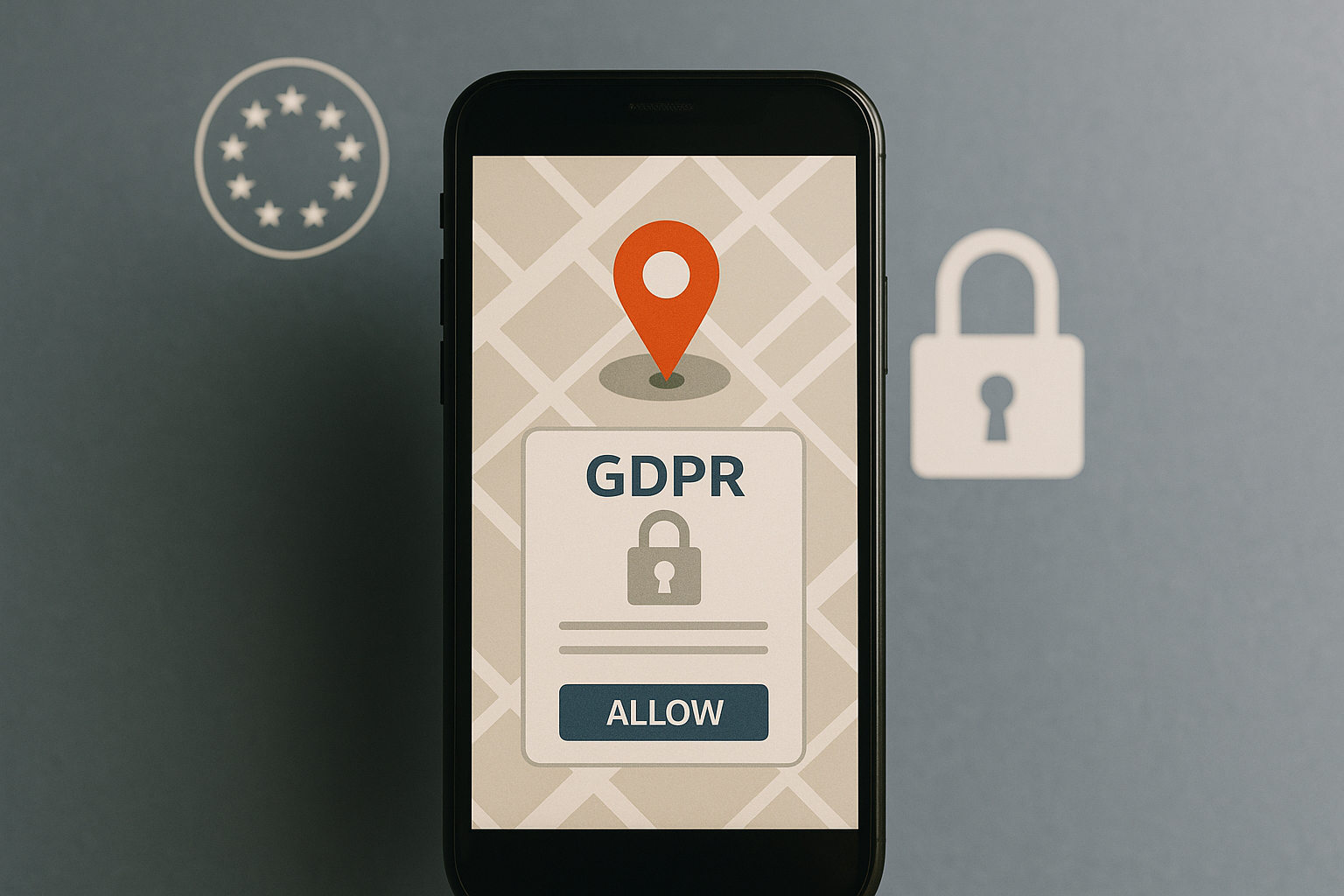Geolocation Data and the GDPR
Geolocation data has become an integral feature of many digital services, from navigation and food delivery to workplace attendance and marketing. While these applications offer value and convenience, they also raise significant concerns under the General Data Protection Regulation (GDPR).
Geolocation data often reveals patterns about a person’s daily life, routines, and behavior. As such, the GDPR treats it as personal data—and, in certain contexts, as particularly sensitive. Organizations that collect, store, or analyze location information must take specific steps to ensure lawful processing, limit risks, and respect individual rights.
This article provides an overview of the compliance requirements related to geolocation data and offers practical recommendations to help organizations process it responsibly and legally.
What Is Geolocation Data and Why It’s Sensitive
Geolocation data refers to information that identifies the geographic position of a device or person. It can be derived from GPS coordinates, Wi-Fi triangulation, mobile networks, or Bluetooth signals. Depending on the precision and context, geolocation data can identify not only where someone is now, but also where they have been—and by implication, what they may be doing.
Even when not combined with a name or email address, location data can lead to identification when linked to recurring behavior or cross-referenced with other data points. For example, regular presence at a particular religious site or medical clinic may reveal sensitive information about an individual’s beliefs or health.
European regulators have increasingly treated location data as high-risk due to its intrusiveness and potential to track individuals covertly. This makes it subject to heightened scrutiny under the GDPR.
Lawfulness and Consent under the GDPR
To process geolocation data, organizations must have a valid legal basis under Article 6 GDPR. In practice, the two most relevant bases are consent and legitimate interest. However, reliance on legitimate interest is rarely appropriate where precise or continuous tracking is involved, particularly for end-user services or employee monitoring.
Consent must meet strict conditions: it must be freely given, specific, informed, and unambiguous. This means that blanket consent buried in general terms and conditions is not sufficient. Users must be able to opt in (not just opt out) and must receive clear information about what is being collected, for what purpose, and for how long.
In mobile apps, this is particularly challenging. Permissions granted through operating systems (e.g. iOS or Android) do not automatically meet GDPR standards unless supported by transparent notices and granular choices. Controllers must also ensure that consent can be withdrawn just as easily as it was given.
Transparency and Purpose Limitation
Transparency is a core principle of the GDPR, and it is especially important when dealing with data that users may not expect to be collected. Privacy notices must clearly describe the categories of location data being collected, the methods of collection (e.g. GPS vs. Wi-Fi), and the purposes for which the data will be used.
Purpose limitation requires that geolocation data be used only for the purposes explicitly communicated to the data subject. If the data was collected for navigation, it cannot be repurposed for targeted advertising or behavior analysis unless new consent is obtained. This principle also restricts excessive data retention and prevents open-ended use.
Controllers must also specify whether the data is shared with third parties and whether it will be transferred outside the EEA. Many location-based services use external analytics or advertising SDKs, which may involve international transfers that trigger additional obligations under Chapter V of the GDPR.
Security and Data Minimization in Location Tracking
Given the sensitivity of location data, Article 32 of the GDPR requires that appropriate technical and organizational measures be in place to secure it. This includes encryption, access controls, and ensuring that location data is not accessible to unauthorized parties—internally or externally.
Equally important is the principle of data minimization. Organizations must assess whether precise location data is necessary for the service provided. For example, a weather app may only need a general location (e.g. city or region), not exact GPS coordinates. Collecting more precise data than needed increases the risk of non-compliance and exposure in the event of a data breach.
Controllers should also consider limiting the frequency and duration of tracking. Continuous or real-time tracking must be clearly justified and subject to regular reviews, including Data Protection Impact Assessments (DPIAs) where required.
Employee Monitoring and Workplace Use Cases
Geolocation data is increasingly used in workplace contexts, from verifying field staff locations to monitoring delivery routes or attendance. However, employee data is subject to stricter expectations around voluntariness, transparency, and proportionality.
Consent is rarely a valid legal basis in employment relationships due to the imbalance of power. Instead, employers must rely on necessity (e.g. for contractual obligations or legitimate interests) and demonstrate that tracking is proportionate, time-limited, and accompanied by safeguards.
Employees must be informed about the scope of tracking, and alternative arrangements must be considered where possible. Covert tracking or excessive monitoring can be challenged by works councils, data protection authorities, or even courts.
Regulatory Enforcement and Guidance
Supervisory authorities across the EU have taken enforcement action against unlawful geolocation practices. In France, the CNIL has sanctioned mobile app providers for collecting location data without valid consent or transparency. In Germany, authorities have questioned the necessity of location tracking in employee management tools.
European Data Protection Board (EDPB) guidelines stress the need for meaningful user control, clear interfaces, and accountability in the design of services that process location data. These guidelines provide a valuable reference point when designing or reviewing services that involve geolocation tracking.
Compliance Checklist for Geolocation Data
To conclude, here is a concise compliance checklist for organizations that process geolocation data:
- Define the legal basis for collecting and using location data; in most cases, consent is required.
- Ensure transparency through clear, accessible privacy notices and user interfaces.
- Minimize data collection to what is strictly necessary for the stated purpose.
- Limit retention and avoid repurposing without renewed consent.
- Secure the data using appropriate encryption and access controls.
- Conduct DPIAs for high-risk or large-scale tracking operations.
- Avoid excessive tracking in employment contexts and use alternative methods where possible.
Conclusion
Geolocation data may appear routine in the digital age, but its implications under the GDPR are far-reaching. Organizations that process such data must tread carefully, ensuring that every aspect—from collection to storage and onward sharing—is subject to lawful basis, transparency, minimization, and security.
By adopting a cautious, well-documented approach, organizations can benefit from the value of geolocation data while staying on the right side of the law. The goal is not to avoid using location data altogether, but to integrate it into services in a way that respects individuals’ rights and meets evolving compliance expectations.



